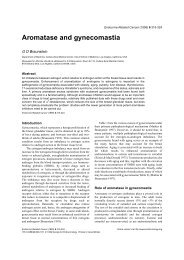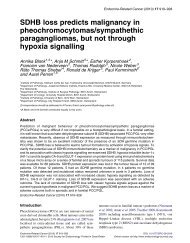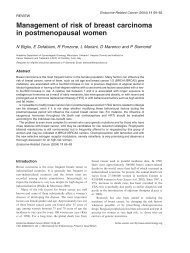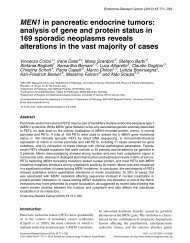Somatostatin-producing neuroendocrine tumors of the duodenum and
Somatostatin-producing neuroendocrine tumors of the duodenum and
Somatostatin-producing neuroendocrine tumors of the duodenum and
Create successful ePaper yourself
Turn your PDF publications into a flip-book with our unique Google optimized e-Paper software.
N Garbrecht, M Anlauf et al.: <strong>Somatostatin</strong>-<strong>producing</strong> <strong>tumors</strong><br />
Hamilton & Aaltonen 2000, Castoldi et al. 2001,<br />
Cappelli et al. 2004, Fendrich et al. 2004). In a review,<br />
<strong>the</strong> reported occurrence <strong>of</strong> duodenal <strong>and</strong> pancreatic<br />
SOM-NETs in NF1 was 43.2 <strong>and</strong> 20.8% respectively<br />
(Soga & Yakuwa 1999). We can confirm <strong>the</strong><br />
occurrence <strong>of</strong> duodenal SOM-NETS in NF1 patients,<br />
but with a lower frequency, <strong>and</strong> were unable to confirm<br />
<strong>the</strong> high rate <strong>of</strong> NF1-associated pancreatic SOM-NETs<br />
reported by Soga & Yakuwa (1999). None <strong>of</strong> our<br />
pancreatic SOM-NETs was associated with NF1.<br />
Pancreatic SOM-NETs have also been described<br />
in patients with MEN1 (Calender et al. 2004,<br />
Levy-Bohbot et al. 2004), but an association <strong>of</strong><br />
duodenal SOM-NETs with MEN1 <strong>and</strong> ZES caused<br />
by multiple duodenal gastrinomas has only recently<br />
been observed (Anlauf et al. 2007). In contrast to <strong>the</strong><br />
MEN1-associated duodenal gastrinomas, <strong>the</strong> MEN1associated<br />
duodenal SOM-NETs have not so far been<br />
identified as a source <strong>of</strong> lymph node metastases.<br />
Pancreatic <strong>and</strong> duodenal NETs have been described<br />
in VHL patients (Maki et al. 1995, Mount et al. 1995,<br />
Karasawa et al. 2001, Chetty et al. 2004). In <strong>the</strong> present<br />
series, none <strong>of</strong> <strong>the</strong> patients with a SOM-NET suffered<br />
from a bona fide VHL syndrome, nor did <strong>the</strong><br />
<strong>tumors</strong> display <strong>the</strong> clear cell cytology usually observed<br />
in VHL-associated pancreatic NETs (Lubensky<br />
et al. 1998).<br />
Larsson et al. (1977) described <strong>the</strong> first case <strong>of</strong><br />
pancreatic SOM-NET presenting with hypochlorhydria,<br />
steatorrhea, <strong>and</strong> diabetic glucose tolerance. Later<br />
case reports <strong>and</strong> reviews described fur<strong>the</strong>r patients with<br />
or without a somatostatinoma syndrome (Krejs et al.<br />
1979, Anene et al. 1995, Sessa et al. 1998, Soga &<br />
Yakuwa 1999, Green & Rockey 2001). However, <strong>the</strong><br />
existence <strong>of</strong> such a syndrome was challenged first by<br />
Stacpoole et al. (1983) in 1983. In an overview by<br />
Tanaka et al. (2000) <strong>and</strong> <strong>the</strong> report by House et al.<br />
(2002), none <strong>of</strong> <strong>the</strong> patients showed any symptoms <strong>of</strong><br />
<strong>the</strong> somatostatinoma syndrome. In a series <strong>of</strong> five<br />
patients with SOM-NETs, Pipeleers et al. (1983)<br />
described three patients with an incomplete somatostatinoma<br />
syndrome. These authors considered <strong>the</strong><br />
extreme variation to be due to marked differences in<br />
<strong>the</strong> circulating levels <strong>of</strong> biologically active somatostatin.<br />
In 2004, Lévy-Bohbot et al. (2004) described<br />
two functionally active pancreatic SOM-NETs in<br />
patients with MEN1. In <strong>the</strong> present series <strong>of</strong> 49<br />
patients with SOM-NETs, we failed to identify any<br />
SOM-NET that met three or more <strong>of</strong> <strong>the</strong> criteria <strong>of</strong> <strong>the</strong><br />
so-called somatostatinoma syndrome (Larsson et al.<br />
1977, Krejs et al. 1979, Dayal et al. 2004). Even in an<br />
extended series <strong>of</strong> 821 patients (with ei<strong>the</strong>r duodenal or<br />
pancreatic NETs) from five centers specializing in<br />
238<br />
NETs, no patients with a bona fide somatostatinoma<br />
syndrome could be identified. The fact that we were<br />
unable to identify a somatostatinoma syndrome in <strong>the</strong><br />
present series may be related to <strong>the</strong> retrospective nature<br />
<strong>of</strong> <strong>the</strong> study, i.e., incomplete recording <strong>of</strong> <strong>the</strong><br />
symptoms <strong>of</strong> <strong>the</strong> patients. To clarify this issue,<br />
prospective studies are needed. However, given that<br />
our data may be confirmed, <strong>the</strong> failure to detect a<br />
somatostatinoma syndrome may be explained by <strong>the</strong><br />
very short biological half-life <strong>of</strong> (monomeric) somatostatin<br />
(Brazeau et al. 1974, Tragl 1987, Pless 2005),<br />
making it almost unable to affect its target cells via <strong>the</strong><br />
circulation. It can <strong>the</strong>refore be anticipated that only an<br />
exceptional tumor is able to produce <strong>and</strong> release<br />
somatostatin in sufficiently large amounts to cause a<br />
full-blown syndrome.<br />
In summary, SOM-NETs were found to be a<br />
frequent tumor type in <strong>the</strong> <strong>duodenum</strong>, but rare in <strong>the</strong><br />
pancreas. <strong>Somatostatin</strong> expression was not restricted to<br />
typical NETs, but also occurred in GCGPs <strong>and</strong><br />
pdNECs. NF1-associated SOM-NETs only occurred<br />
in <strong>the</strong> <strong>duodenum</strong>, particularly in <strong>the</strong> ampullary region,<br />
while MEN1-associated SOM-NETs occurred in both<br />
<strong>the</strong> <strong>duodenum</strong> <strong>and</strong> <strong>the</strong> pancreas. According to <strong>the</strong><br />
WHO criteria, most duodenal <strong>and</strong> pancreatic SOM-<br />
NETs were malignant, but surgical treatment resulted<br />
in long-term survival in many patients. A somatostatinoma<br />
syndrome was not observed; it appears to<br />
be uncommon.<br />
Acknowledgements<br />
The authors are grateful to Maike Pacena, Anja<br />
Bredtmann, <strong>and</strong> Sonja Schmid for <strong>the</strong>ir excellent<br />
technical assistance. We are indebted to Waldemar<br />
Strauss for <strong>the</strong> photo documentation <strong>and</strong> Ka<strong>the</strong>rine<br />
Dege for carefully reading <strong>the</strong> manuscript. We<br />
thank all colleagues who supported this study:<br />
Drs A Akovbiantz, Zürich; H P Bange, Gaarding; G<br />
Baretton, Dresden; M Barten, Rostock; D B von<br />
Bassewitz, Münster; D Berger, Baden-Baden;<br />
R Beverungen, Höxter-Lüchtringen; Bode, Weener/-<br />
Ems; T Bozkurt, Koblenz; J Braun, Bremen;<br />
K Buchhardt, Bremen; P Buchmann, Zürich;<br />
A Burkhardt, Reutlingen; J Caselitz, Hamburg;<br />
T Czerny, St Gallen; J Erhard, Dinslaken; S Eidt,<br />
Köln; M Gregor, Tübingen; F Hagenmüller, Hamburg;<br />
B Van den Heule, Brüssel; K <strong>and</strong> T Jatzkewitz, Kiel;<br />
De Jonge, Wilrijk; K Junke, Bremen; F Fändrich, Kiel;<br />
G Fischer, Wilhelmshaven; P Flemming, Celle;<br />
RGützkow, Eutin; D Henne-Bruns, Ulm; S Hollerbach,<br />
Celle; M Kindler, Aachen; E Klar, Rostock;<br />
B Kremer, Kiel; J Kühne, Oldenburg; T Lehnert,<br />
www.endocrinology-journals.org






